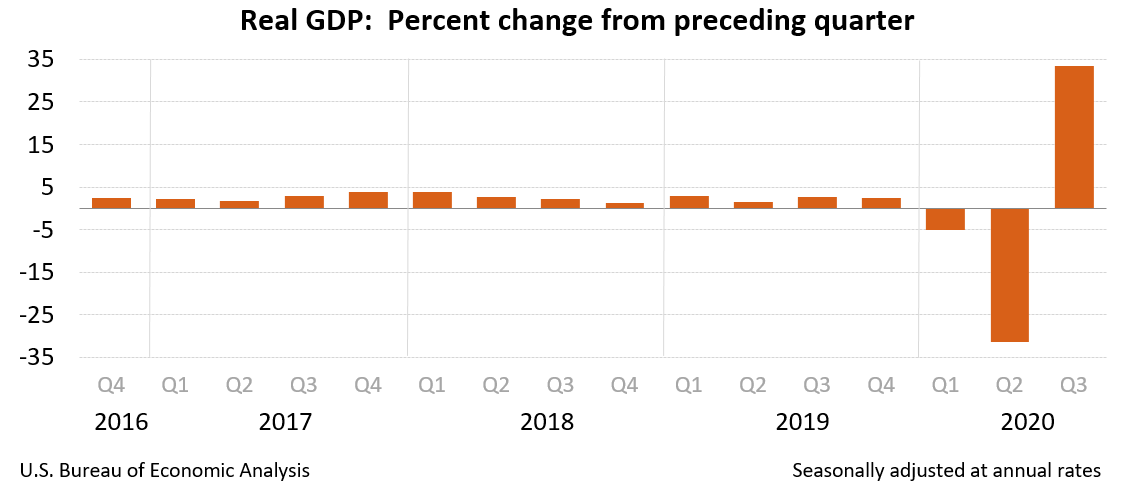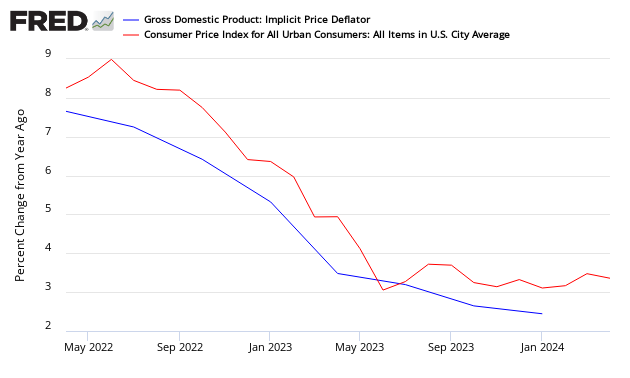Third Estimate 3Q2020 GDP Improves Marginally To 33.4%. Corporate Profits Improve
The third estimate of third-quarter 2020 Real Gross Domestic Product (GDP) improved from the second estimate's positive 33.1 % to 33.4 %.

Analyst Opinion of GDP
The coronavirus recovery is the reason for the improvement from the previous quarter - and pushed GDP quarter-over-quarter growth to record levels.
I am not a fan of the quarter-over-quarter exaggerated method of measuring GDP - but the recovery from the pandemic is not over as the year-over-year GDP growth remains in contraction.
The market expected (from Econoday):
| Seasonally Adjusted Quarter-over-Quarter Change at an annual rate | Consensus Range | Consensus |
Advance Actual |
Second Actual |
Third Actual |
| Real GDP - Q/Q change - SAAR | 33.0 % to 33.7 % | +33.1 % | +33.1 % | +33.1 % | |
| Real Consumer Spending - Q/Q change - SAAR | +40.7 % | +40.6 % |
- Headline GDP is calculated by annualizing one quarter's data against the previous quarter's data. A better method would be to look at growth compared to the same quarter one year ago. For 3Q2020, the year-over-year growth is now -2.6 % - up from 2Q2020's -9.0 % year-over-year. So one might say that the rate of GDP growth accelerated by 6.4 % from the previous quarter.

Real GDP Expressed As Year-over-Year Change
The same report also provides Gross Domestic Income which in theory should equal Gross Domestic Product. Some have argued the discrepancy is due to misclassification of capital gains as ordinary income - but whatever the reason, there are differences.
Real GDP (blue line) Vs. Real GDI (red line) Expressed As Year-over-Year Change
This third estimate released today is based on more complete source data. (See caveats below.)
Real GDP per Capita
The table below compares the previous quarter estimate of GDP (Table 1.1.2) with the current estimate this quarter which shows:
- consumption for goods and services improved and added 25.4 % to GDP.
- trade balance declined and removed 3.2 % from GDP
- inventories grew and added 6.6 % to GDP
- fixed investment improved and added 5.4 % to GDP
- government spending decline and removed 0.8 % from GDP
The following is Table 1.1.2: [click to enlarge]
z gdp_table.png
What the BEA says about the third estimate of GDP:
The increase in third quarter GDP reflected continued efforts to reopen businesses and resume activities that were postponed or restricted due to COVID-19. The full economic effects of the COVID19 pandemic cannot be quantified in the GDP estimate for the third quarter of 2020 because the impacts are generally embedded in source data and cannot be separately identified.
The increase in real GDP reflected increases in PCE, private inventory investment, exports, nonresidential fixed investment, and residential fixed investment that were partly offset by decreases in federal government spending (reflecting fewer fees paid to administer the Paycheck Protection Program loans) and state and local government spending. Imports, which are a subtraction in the calculation of GDP, increased
Inflation continues to moderate as the "deflator" which adjusts the current value GDP to a "real" comparable value continues to moderate. The following compares the GDP implicit price deflator year-over-year growth to the Consumer Price Index [this puts both on the same basis for comparision]:
What the BLS says about the revision from the second to the third estimate:
In the third estimate, the change in third-quarter real GDP was revised up 0.3 percentage point from the second estimate. The updated estimates primarily reflected upward revisions to consumer spending and nonresidential fixed investment that were partly offset by a downward revision to exports.

Corporate Profits
Profits from current production (corporate profits with inventory valuation and capital consumption adjustments) increased $499.6 billion in the third quarter, in contrast to a decrease of $208.9 billion in the second quarter.
Profits of domestic financial corporations increased $12.1 billion in the third quarter, compared with an increase of $26.5 billion in the second quarter. Profits of domestic nonfinancial corporations increased $436.2 billion, in contrast to a decrease of $145.9 billion. Rest-of-the-world profits increased $51.3 billion, in contrast to a decrease of $89.5 billion. In the third quarter, receipts increased $113.0 billion, and payments increased $61.7 billion.
Caveats on the Use of Gross Domestic Product (GDP)
GDP is a market value of all final goods and services produced within the USA where the money is used in the transaction - and it is expressed as an annualized number. GDP = private consumption + gross investment + government spending + (exports − imports), or GDP = C + I + G + (X - M). GDP counts monetary expenditures. It is designed to count the value added so that goods are not counted over and over as they move through the manufacture - wholesale - retail chain.
The vernacular relating to the different GDP releases:
"Advance" estimates, based on source data that are incomplete or subject to further revision by the source agency, are released near the end of the first month after the end of the quarter; as more detailed and more comprehensive data become available, "second" and "third" estimates are released near the end of the second and third months, respectively. The "latest" estimates reflect the results of both annual and comprehensive revisions.
Consider that GDP includes the costs of suing your neighbor or McDonald's for hot coffee spilled in your crotch, plastic surgery or cancer treatment, buying a new aircraft carrier for the military, or even the replacement of your house if it burns down - yet little of these activities is real economic growth.
GDP does not include home costs (other than the new home purchase price even though mortgaged up to the kazoo), interest rates, bank charges, or the money spent buying anything used.
It does not measure wealth, disposable income, or employment.
In short, GDP does not measure the change of the economic environment for Joe Sixpack and Joe Sixpack's kid, yet pundits continuously compare GDP across time periods.
Although there always will be some correlation between all economic pulse points, GDP does not measure the economic elements that directly impact the quality of life of its citizens.
Disclaimer: No content is to be construed as investment advise and all content is provided for informational purposes only.The reader is solely responsible for determining whether any investment, ...
more








